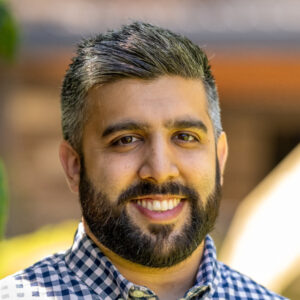This is Zaki, Program Director at Aspen Digital and part of the team spearheading the Digital Equity Accelerator, an exciting new initiative helping communities scale their efforts to close the global digital divide that we’re piloting this year in the U.S., India, and Morocco. As we get closer to launching the Accelerator’s inaugural cohort, we’re celebrating inspirational stories from innovators on the frontlines.
I recently had the pleasure of connecting with one of the Accelerator’s advisors, Shahed Amanullah, who has spent his career developing innovative approaches for shifting power and equity, often to marginalized communities, including in all three of our 2022 pilot countries. Shahed has built startups from scratch into internationally successful social good companies, served in government as a senior advisor to former Secretary of State Hillary Clinton on global social entrepreneurship, and now helps other diverse innovators grow their impact. Given that background, I was thrilled to have him join our Advisory Council and to have the chance to get his perspective on the work ahead.
Zaki: What’s one inspiring example you’ve seen firsthand of how innovation can advance social equity?
Shahed: I have spent many years advising, mentoring, and investing in startups in the developing world, and what never ceases to amaze me is how many of those companies actively embed inclusion and equity into their business models from the start, rather than as an afterthought. For example, I worked with one handicrafts company in North Africa that built out their staff to include people with disabilities. It is inspiring to see startups in the developing world who want to be successful and not leave their communities behind as they do so.
Z: Our Accelerator supports diverse communities that are working to address digital inequity in different parts of the world. “Digital equity” can also mean different things depending on the community, region, culture, and other factors. What’s important to keep in mind when it comes to taking such a global look at digital equity?
S: Digital inequity is often framed as either an inability to access the Internet or an inability to make productive use of it once we do. But one angle we often overlook is the state of culture within underserved communities, regardless of the digital prowess of those within them. When we discuss digital inequity within underserved communities, what we are saying is that those communities need to be transformed into connected ones, regardless of the impact those online experiences have on them. The process of alleviating digital inequity needs to include people from within those communities who actively evaluate how that transformation will affect different facets of that society, and then allow them to make appropriate decisions for themselves. Digital equity must first and foremost respect the rights of communities to determine the shape of their own digital futures.
The ability to innovate is equally distributed, but the ability to turn those innovations into things that benefit us is not. This is the divide we need to address.
Shahed Amanullah, Frost Capital and Zakatify
Z: Why is it important that social impact innovators come from and are connected to the communities they serve?
S: Because we have to shed the arrogant notion that innovation only comes from tech-heavy communities like Silicon Valley. I have seen people try to transplant “innovations” from America to developing countries, and they either do not solve problems specific to those communities or they try unsuccessfully to transform those societies into ones that work like ours. If we would just listen to (and empower) the innovators in those communities, we would hear solutions that we in the “developed” world could never think of ourselves. The ability to innovate is equally distributed, but the ability to turn those innovations into things that benefit us is not. This is the divide we need to address.
Z: What can the U.S. learn from approaches used in developing countries and vice versa?
S: Developing countries breed innovators that work differently than they do here. In Silicon Valley, we see a new technology and ask ourselves, “What problem could this tool solve?” But in developing countries, they often flip the question to, “What tools could we use to solve this problem?” The latter approach is a much more honest form of innovation in that it is focused on solving the problem in the simplest, most elegant way possible — even if it isn’t sexy or modern. We have to back away from our idolization of technology and shiny new tools and focus on the end user first. It’s ironic that we talk about “human centered design” when innovators in developing countries actually embrace that ethos much better than we do.
Z: What’s a component of digital equity that is often overlooked or that needs more attention from nonprofits or funders?
S: We need to rethink the idea of “digital literacy” and spend time focusing on how digital spaces transform, for better or worse, the communities that adopt them. We simply have not spent enough time examining the long-term effects of throwing open the gates and allowing everyone in. Digital spaces were not originally built for everyone, nor is everyone prepared for how those spaces will transform them. How can we help people make educated decisions about how digital inclusion will change them for better or worse? And how can we respect the rights of people to make their own choices as to how much they want to be in those spaces without feeling shame for being offline?
Z: What approach would you recommend to a nonprofit seeking to increase or diversify their institutional funding?
S: Nonprofits, like for-profit companies, have target markets that need to be satisfied in order to prove their worth. For a nonprofit that makes their target market happy, I advise them to consider adding a revenue model that involves payment for at least some of their services. Just as for-profit companies start to edge toward social responsibility through B-corps and the like, nonprofits can become more like companies and start serving their target markets in different ways, starting with free services but also including paid ones that complement those, so long as those paid services fall within the mission of the nonprofit. The best of these can slowly wean themselves away from grants and large donors whose missions may not exactly align, and can provide a more steady and dependable revenue stream.
Z: What advice would you give an organization that’s already improving outcomes for underserved communities and would like to advance digital equity for that group but doesn’t know where to begin?
S: Organizations that are already addressing unmet needs in underserved communities can come up with digital analogs or accessories that complement (but do not replace) their primary services. By offering both, you can reach people at their own comfort level and provide an on-ramp for getting people to slowly adopt digital means to acquire the same services. As people begin to adopt digital tools organically, rather than forcing them on individuals in order to benefit, we will create a more humane, compassionate, and contextual onramp to a digital life that is consistent with the values of those communities.




